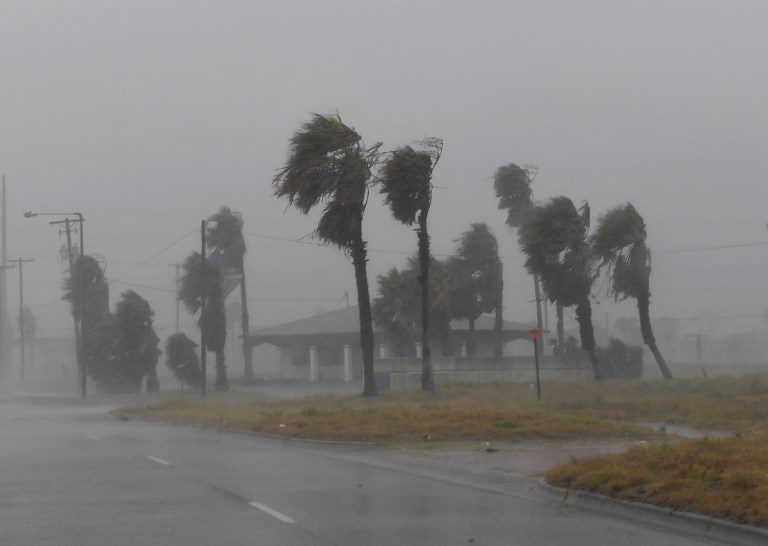SUMMARY
This is AI generated summarization, which may have errors. For context, always refer to the full article.

CORPUS CHRISTI, USA – Hurricane Harvey slammed into the Texas coast late Friday, August 25, unleashing torrents of rain and packing powerful winds, the first major storm to hit the US mainland in 12 years.
The storm roared ashore at the town of Rockport – near Corpus Christi, a major US oil industry hub – packing sustained winds of 130 miles per hour (215 kilometers per hour), a Category 4 hurricane on the 5-level storm scale.
A few hours later the storm made a second landfall just north of Rockport as a Category 3 hurricane, with winds of 125 mph, the National Hurricane Center said.
Harvey lost strength as it moved inland over south Texas and dropped to a still-dangerous Category Two storm, with winds of 100 mph, and then to a Category One with winds of 90 mph, the NHC said at 1000 GMT.
President Donald Trump granted Texas Governor Greg Abbott’s request to declare a “major disaster” zone in the state to speed federal aid to the millions in harm’s way. Abbot in turn activated more than 1,000 National Guardsmen to help with evacuation and recovery.
The NHC warned of likely “catastrophic and life-threatening flooding” due to the massive rainfall forecast and the huge storm surge, which could reach 13 feet (nearly four meters) in some places.
“Harvey is expected to slow down through the day and meander over southeastern Texas through the middle of next week,” the NHC said.
Oil production crippled
Meteorologists warned that tornadoes were possible through Saturday, August 25, from Texas into Louisiana, which is also expected to take a major hit.
The powerful storm has forced hundreds of thousands to flee their homes and crippled oil production in the Gulf.
Rockport Mayor Patrick Rios had blunt words for those determined to stay, telling them to “mark their arm with a Sharpie pen, put their social security number” – to identify them if they were found dead.
There was widespread tree damage in Rockport and vehicles damaged “all over the place,” as well as 10 people injured from roof collapses, City Manager Kevin Carruth told the Corpus Christi Caller-Times around midnight.
As he headed to the Camp David presidential retreat for the weekend with his family, Trump said: “Good luck to everybody.”
Supermarkets stripped bare
Harvey, the most powerful hurricane to hit the mainland since Wilma struck Florida in 2005, could dump up to 40 inches (more than one meter) of rain on the area over the next few days – and cause billions of dollars in damage.
2005 was a huge year for hurricanes – before Wilma, Hurricane Katrina pummeled New Orleans, leaving more than 1,800 dead and becoming one of the greatest domestic headaches for then-president George W. Bush.
Coastal Texas is a fast-growing area, with some 1.5 million people moving into the area since 1999. (READ: Millions brace as Hurricane Harvey threatens Texas, Louisiana)
Authorities said the combination of dense growth and perhaps a year’s worth of rain falling in just four or five days could prove deadly.
Supermarket aisles were stripped bare, homes and shops had boarded up windows.
The NHC warned of the “complete destruction of mobile homes,” of many buildings “washing away,” and some areas being left “uninhabitable for weeks or months”.
‘More powerful than projected’
In 2005, Bush faced severe criticism after FEMA appeared unprepared for the devastating damage inflicted by Hurricane Katrina.
In a series of tweets throughout Friday, Trump said he was closely monitoring the storm’s progress.
Storm turned Hurricane is getting much bigger and more powerful than projected. Federal Government is on site and ready to respond. Be safe!
— Donald J. Trump (@realDonaldTrump) August 25, 2017
“Storm turned Hurricane is getting much bigger and more powerful than projected. Federal Government is on site and ready to respond. Be safe!” he wrote after arriving at Camp David.
In Corpus Christi, many residents appeared bent on sitting the storm out, packing sandbags to protect their homes – until the supply of sandbags ran out.
As the storm struck city officials urged residents to boil tap water as a precautionary measure.
Sheriff Frank Osborne of Matagorda County, where evacuations were mandatory, told local TV station KHOU that he would not risk the lives of his deputies “to save somebody that didn’t leave when they were asked to.”
Officials in Houston, the most populous city in the storm’s path, closed its port but did not anticipate mass evacuations.
Inland cities like San Antonio welcomed evacuees, but some at the shelters told Agence France-Presse that supplies were lacking.
FEMA chief Brock Long said the most pressing danger was the storm surge, but also said many inland counties should prepare for “significant” flooding.
US authorities said about 22 percent of crude production in the Gulf of Mexico was shut down as of Friday – accounting for more than 375,000 barrels a day.
But total US production stands at 9.5 million barrels a day, experts say.
Meteorologist Eric Holthaus told AFP the prospect of the storm stalling on the coast, lashing it with heavy rain for days, was “just terrifying.”
In Louisiana, Governor John Bel Edwards issued an emergency declaration for his entire state, as authorities in New Orleans – where Katrina did the most damage – readied high-water rescue vehicles and boats.– Rappler.com
Add a comment
How does this make you feel?
There are no comments yet. Add your comment to start the conversation.